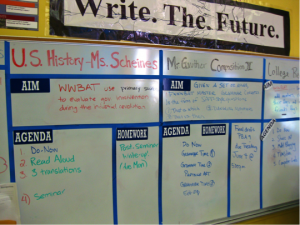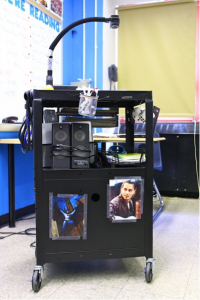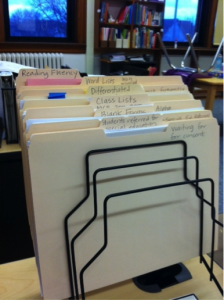How to Organize the Daily Teaching Flow
By Maia Heyck-Merlin
The daily rotation. We see it in schools everywhere. Students move, teacher stays. Teacher moves, students stay. Students go, teacher goes.
Whether your school is overcrowded or departmentalized, the days of one teacher standing before the same 28 smiling student faces all day are fading fast. Life has become more complicated, requiring additional planning and preparation—on top of our already hectic jobs.
I see middle grades teachers fall into the following categories:
• The stationary, or traditional, classroom – One teacher, same group of students, same classroom (though this arrangement is becoming increasingly rare!)
• The rotating classroom – One teacher, rotating groups of students who travel to you in your classroom
• The traveling teacher – Teacher travels to multiple classrooms around the building
No matter what your situation, or combination of situations, there’s a good chance you no longer have a traditional teacher desk on which to set out your materials, or enough time to “turn over” your classroom for the next class, or a moment to talk with students after class.
Five tips to help manage the flow
Each teacher category above faces its own unique challenges. Teachers in stationery classrooms must manage time blurring across the day without set periods—and occasionally getting to the end of the day without having taught science (hey, it happened to me!)—AND not ever getting a chance to reset the classroom, student behavior or their own mental psyche. Those of us who teach in rotating classrooms or travel deal with moving bodies, materials management, and bell schedules that often force us to sacrifice some portion of our lesson.
No matter your situation, here are five tips to help make your teaching stronger and your life easier.
1) Prepare as much as physically possible the night before.
Traveling teachers: this means asking the teachers(s) with whom you share classrooms if you can cordon off the whiteboard to have separate space for your learning objectives, class agenda, and homework. If you cannot get any space, buy a poster paper carrying tube so you can simply unfurl the day’s plan on chart paper (written out the night before) at the moment you enter the room.
Stationary teachers might try having chart paper or whiteboard space with class overviews for all five (or more!) subjects prepped and ready to go. All teachers that I have interviewed spend time the prior afternoon or the morning of their lesson getting their space ready; this way, they are not doing this prep in the middle of the teaching day while a classroom of 7th graders “waits patiently.”
2) Ensure your materials are truly mobile.
Traveling teachers fortunate enough to work in a school with elevators keep incredibly creative teaching carts, stocked full of materials to distribute, markers, pens, AV equipment, snacks, and more. For traveling teachers subject to stairs (or in my case, trailers/portables with lots of steps and an outside walk between each one), you may want to invest in a backpack and one or two sturdy tote bags.
But even if you don’t travel, this is hugely important.
In the stationery classroom, carefully lay out materials for all subjects a day (or a week!) in advance. Many folks keep a plastic crate for each subject for the week. Inside the crate are all of the needed materials. For example, the science crate may hold all of the supplies for the fossil lesson and inside the math crate might be the manipulatives needed to introduce Wednesday’s geometry unit.
This prevents mid-lesson fumbling through your supply closets and also makes it easier to. . .
3) Employ student helpers. If you are a traveling teacher, you are on a tight, tight timeline to get in and out of classrooms. Tasks like attendance, checking homework, collecting papers, and tracking behavior can be easily forgotten…or they can accidentally take over the whole period! Consider asking a student to be your paper collector and sorter, to take attendance for you, or to hang up your visual anchors in advance of the class. This will give you the time to teach, and your students the time to learn. (Editor’s note: see this MW interview for more ideas.)
4) Set clear expectations for student papers. As a teacher, you are dealing a massive amount of important kid papers that give you insight into what your students are actually learning. It is all too easy to just collect everything and grade nothing. When you are writing your lessons, plan ahead to be judicious in what you collect and how you collect it. Know what you are scanning for in class — completion or accuracy — and how you will record that data.
Another trick is to develop an airtight system to bring each class to a close. Assign students numbers that alphabetically correspond to their names, and ask a helper to put papers in that order after collection. You’ll be surprised by how much time this saves when you’re grading.
Always make sure you have a particular place to put papers. Resist the urge to dump them on your desk or cart. Many teachers make great use of folders or accordion files, in which they can insert papers for particular classes. When you return papers to students, make sure they do not just get shoved in their desks, backpacks or lockers. Be clear what should go home and stay home, what should be saved in student binders to reference or study for tests, and what should be archived in portfolios.
5) Manage your energy. I’m a big fan of Tony Schwartz’s work at The Energy Project. He’s taught me much of what I know about managing my own energy on a regular basis. Whether you’re a stationery, rotating classroom or traveling teacher, the constant presence of students makes it hard to hydrate and nourish yourself. If you are fortunate enough to have a desk, stock it full of healthy snacks, like fruit, nuts (if allowed), granola bars, energy bars, water, and other non-perishables. If your students have a set snack time, be sure to eat when they eat. If you are a traveling teacher, keep a Ziploc bag full of snacks on your cart or in your tote bag or backpack. Many teachers I know eat small meals throughout the teaching day to keep energy flowing, particularly in the afternoon. While it’s tempting to scour your school for soda and candy around 4:00 PM, try to have a protein-based snack on hand instead for this potential slump period.
Teaching is challenging. We all know this. Teaching in the middle grades, with important content, moving teachers, mobile classrooms and transitioning students makes your job even harder. Thankfully, with some advance planning, clear systems, and creativity, we can maximize learning for our students each day—all while keeping ourselves sane!
[Read two reviews of Maia’s book The Together Teacher – by Beth Fabijanic and Ariel Sacks – here at MiddleWeb.]
Maia Heyck-Merlin is a former middle grades teacher. She taught fourth grade language arts (students moved), fourth grade writing (she traveled!), and then fifth-grade self-contained. She has also been a non-profit executive and charter school leader. Maia is author of the recently published The Together Teacher: Plan Ahead, Get Organized, and Save Time. Learn more about her work at www.thetogetherteacher.com.









































Really like this article. Taught for two years and still found helpful tips in it. Great site!
getting ready to travel on a cart for the first time, this info was helpful MERCI!
Starting New this year. Thank you so much For sharing your ideas and helpful tips!!